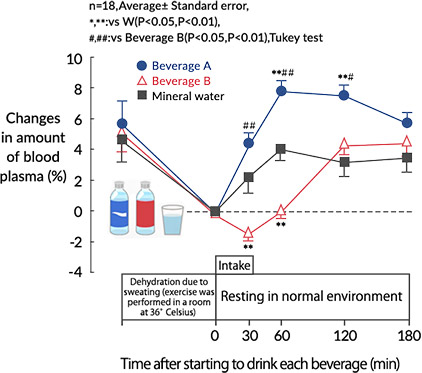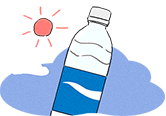What you should drink to prevent heat disorders
The importance of considering the type of sugar contained in electrolyte drinks
One effective way of preventing heat disorders is to quickly restore and maintain the decreased volume of blood plasma by rehydrating with a drink containing salt (sodium) and sugar. However, recent research has demonstrated that the restoration of the plasma volume*1 differs depending on the type of sugar the drink contains.
- *1Plasma volume: The liquid component of blood from which the blood cells (red blood cells, white blood cells, platelets) have been removed.
Study overview
The study compared the differences in the recovery of blood volume after heavy sweating by comparing the consumption of two types of beverages with different sugar compositions.
Subjects
18 healthy adult males who exercised regularly
Average age: 22
Average body weight: 66.8kg
Study design
The study employed the crossover comparison method
(An individual subject goes through a number of conditions in random order and the results are compared)
The subjects went through three tests, drinking beverage A, beverage B, and mineral water in random orders.
Method
Subjects rode stationary bikes (at an intensity of 70% VO2 max) in a room maintained at 36℃ with 40% humidity until they lost fluid equivalent to 2% of body weight through sweat. Then, they drank the same amount of a beverage (beverage A, beverage B, or mineral water) as the amount of sweat lost.
Beverages used in the study
| Beverage A | Carbohydrate-electrolyte beverage containing glucose and fructose (less than 90% fructose) Nutritional composition (per 100ml): 6.2 grams carbohydrates, 49mg sodium Sugar sources: Table sugar, isomerized glucose syrup*2, fruit juice |
|---|---|
| Beverage B | Carbohydrate-electrolyte beverage containing mainly fructose (90% or more fructose) Nutritional composition (per 100ml): 4.7 grams carbohydrates, 34mg sodium Sugar sources: high-fructose corn syrup, honey |
| Control beverage | Mineral water |
- *2Sugar (sucrose): One molecule of glucose bound to one molecule of fructose; after ingestion, it is split into glucose and fructose and absorbed.
Study results
Plasma volume recovered when drinking a beverage, but the recovery proceeded differently depending on the beverage. Recovery of plasma volume was faster with beverage A, which contained glucose and fructose, than mineral water, and it rose to a higher level. However, with beverage B, which contained mainly fructose, plasma volume did not increase until nearly an hour after drinking the beverage, and recovery was slower than either beverage A or mineral water.

Discussion
With beverage A, which contained glucose and fructose, the recovery of plasma volume was faster than with mineral water and it rose to a higher level. It may be considered that this occurred because both the glucose and fructose, in addition to the sodium in the beverage, accelerated the absorption of fluid in the intestinal tract. It is also thought that the sodium in the beverage worked to maintain a high plasma volume.
On the other hand, with beverage B, which contained mainly fructose, plasma volume recovery was slower than not only beverage A, but also slower than mineral water. It may be considered that this occurred because fluid could not be absorbed from the intestinal tract due to the slow absorption of the fructose.
These results suggest that it is necessary to consider not only the amount and composition of electrolytes, but also the type of the sugars contained in a carbohydrate-electrolyte beverage for appropriate rehydration.






